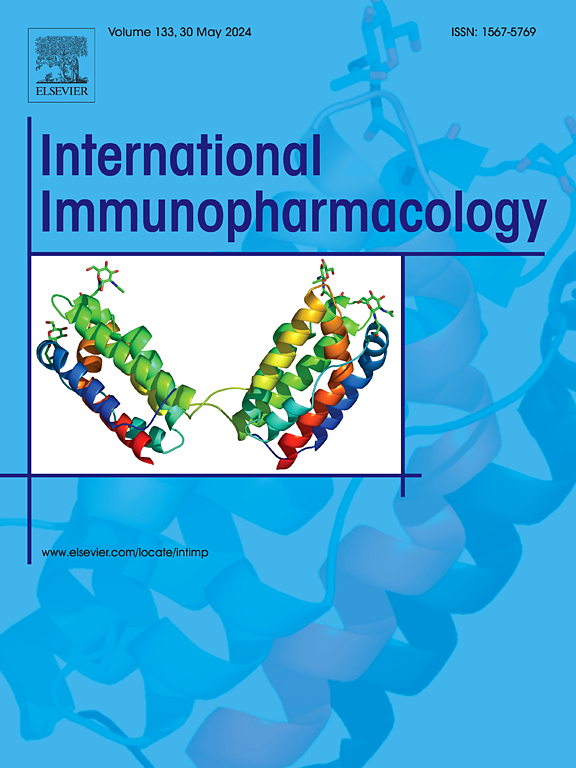Sea buckthorn leaves and gallic acid inhibit C48/80-induced pseudo-allergic reaction via the PLC/IP3 signaling pathway both in vitro and in vivo
IF 4.7
2区 医学
Q2 IMMUNOLOGY
引用次数: 0
Abstract
A pseudo-allergic reaction is an abrupt, IgE-independent reaction that is similar to an allergic reaction. Sea Buckthorn leaves (SBL) have been extensively researched for their pharmacological benefits, including immunological modulation, anti-inflammatory and anti-tumor properties. However, at present, its anti-pseudo-allergic effect are remains to be assessed. In this work, the therapeutic impact and mechanism of SBL extract and its active monomer gallic acid (GA) on pseudo-allergic reaction were studied. A total of 61 SBL extract components were identified using UPLC-Q-Exactive-Orbitrap-MS and HPLC, of which the main component GA was 16.73 ± 0.30 mg/g. GA was identified as the primary active ingredient in SBL extract through hyaluronidase inhibition experiments and molecular docking techniques. It was found that SBL extract and GA reduced capillary dilatation and the rate of paw swelling and Evans blue exudation in C48/80-induced passive cutaneous anaphylaxis (PCA). In C48/80-induced mice systemic allergy model, SBL extract and GA were observed to reverse the reduction in body temperature and block the release of allergic mediators histamine and inflammatory factors TNF-α, CCL2, and IL-6. Using the C48/80-induced RBL-2H3 cells model, it was further demonstrated that SBL extract and GA prevented RBL-2H3 cells activation in vitro, which lowered the release of allergy mediators histamine and β-hexosaminidase as well as inflammatory factors TNF-α, CCL2, and IL-6. SBL extract and GA also reduced intracellular Ca2+ concentration. Furthermore, the phosphorylation levels of PLC γ1 and IP3 could be downregulated by SBL extract and GA. To sum up, SBL extract and GA reduced pseudo-allergic reactions brought on by C48/80 and are anticipated to be created as novel medications to treat pseudo-allergic reactions.

沙棘叶和没食子酸通过PLC/IP3信号通路在体外和体内抑制c48 /80诱导的假过敏反应
伪过敏反应是一种突然的、不依赖于ige的反应,类似于过敏反应。沙棘叶(SBL)的药理作用已被广泛研究,包括免疫调节、抗炎和抗肿瘤特性。但目前,其抗假性过敏的效果还有待评估。本文研究了SBL提取物及其活性单体没食子酸(GA)对假性过敏反应的治疗作用及其机制。通过UPLC-Q-Exactive-Orbitrap-MS和HPLC共鉴定出61种SBL提取物成分,其中主要成分GA为16.73±0.30 mg/g。通过透明质酸酶抑制实验和分子对接技术,确定GA为SBL提取物的主要活性成分。结果发现,SBL提取物和GA可降低c48 /80诱导的被动皮肤过敏反应(PCA)的毛细血管扩张、足部肿胀和Evans蓝渗出率。在c48 /80诱导的小鼠全身过敏模型中,观察到SBL提取物和GA可以逆转体温下降,阻断过敏介质组胺和炎症因子TNF-α、CCL2和IL-6的释放。通过c48 /80诱导的RBL-2H3细胞模型,进一步证明SBL提取物和GA在体外抑制RBL-2H3细胞的活化,从而降低过敏介质组胺和β-己糖氨酸酶的释放以及炎症因子TNF-α、CCL2和IL-6的释放。SBL提取物和GA均能降低细胞内Ca2+浓度。此外,SBL提取物和GA可下调PLC γ1和IP3的磷酸化水平。综上所述,SBL提取物和GA减少了C48/80引起的假性过敏反应,有望成为治疗假性过敏反应的新型药物。
本文章由计算机程序翻译,如有差异,请以英文原文为准。
求助全文
约1分钟内获得全文
求助全文
来源期刊
CiteScore
8.40
自引率
3.60%
发文量
935
审稿时长
53 days
期刊介绍:
International Immunopharmacology is the primary vehicle for the publication of original research papers pertinent to the overlapping areas of immunology, pharmacology, cytokine biology, immunotherapy, immunopathology and immunotoxicology. Review articles that encompass these subjects are also welcome.
The subject material appropriate for submission includes:
• Clinical studies employing immunotherapy of any type including the use of: bacterial and chemical agents; thymic hormones, interferon, lymphokines, etc., in transplantation and diseases such as cancer, immunodeficiency, chronic infection and allergic, inflammatory or autoimmune disorders.
• Studies on the mechanisms of action of these agents for specific parameters of immune competence as well as the overall clinical state.
• Pre-clinical animal studies and in vitro studies on mechanisms of action with immunopotentiators, immunomodulators, immunoadjuvants and other pharmacological agents active on cells participating in immune or allergic responses.
• Pharmacological compounds, microbial products and toxicological agents that affect the lymphoid system, and their mechanisms of action.
• Agents that activate genes or modify transcription and translation within the immune response.
• Substances activated, generated, or released through immunologic or related pathways that are pharmacologically active.
• Production, function and regulation of cytokines and their receptors.
• Classical pharmacological studies on the effects of chemokines and bioactive factors released during immunological reactions.

 求助内容:
求助内容: 应助结果提醒方式:
应助结果提醒方式:


